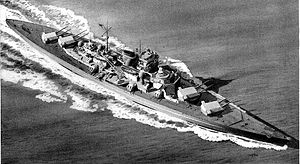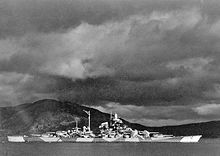- Operation Obviate
-
Operation Obviate Part of Battle of the Atlantic (1939–1945) 
The TirpitzDate 29 October 1944 Location Tromsø, Norway
69°40′N 18°57′E / 69.667°N 18.95°EResult Minor damage, no direct hits Belligerents  RAF Bomber Command
RAF Bomber Command Kriegsmarine
KriegsmarineCommanders and leaders Group Captain "Willie" Tait KzS Wolf Junge Strength 37 Avro Lancasters German battleship Tirpitz (Bismarck class battleship) Operation Obviate was the RAF Bomber Command attack on the German battleship Tirpitz at Tromsø on 29 October 1944. The attack was foiled by cloud covering the ship at the last minute, and the bombs that were dropped caused only minor damage. The Tirpitz would finally be sunk in Operation Catechism two weeks later.
Contents
Background
The Tirpitz was a Bismarck class battleship of 42,900 tons, armed with eight 38 cm (15 inch) guns. She was designed to attack merchant shipping in the Atlantic, but the loss of the Bismarck and other commerce raiders led to instructions that she should be used for limited sorties only. In early 1942, the Tirpitz was sent to northern Norway, where she would remain for most of World War II. She acted mainly as a fleet in being, threatening the Arctic convoys and tying up three British battleships that were needed elsewhere.[1]
The Tirpitz had been damaged in Kåfjord by a raid (Operation Paravane) on 15 September 1944 by No. 617 Squadron and No. 9 Squadron RAF from a base in Russia. The Germans decided that the ship could not be repaired and towed her 200 miles south, for use as a static battery in the defence of Tromsø against an expected Allied invasion. The British were unaware of the damage and so continued plans to sink the Tirpitz. However the move to Tromsø had brought her within range of aircraft flying from British airfields such as RAF Lossiemouth.
Battleplans
When news came of the Tirpitz' move to Tromsø, Air Vice Marshal Ralph Cochrane of No. 5 Group RAF made plans for an attack using Tallboy bombs dropped from high altitude to penetrate the battleship's armour. However Tromsø was at the limits of the range of an Avro Lancaster bomber carrying a Tallboy. The planes needed an extra 300 gallons of fuel, but the Tallboy prevented the use of extra fuel tanks in the bomb bays.[2] Cochrane's engineering staff officer, Wing Commander Brown, came up with the idea of using long, thin tanks from the Wellington inside the fuselage of the Lancasters.[2] This gave them a fuel capacity of 2,406 gallons, just enough for the 2,250 mile trip,[3] but it left the aircraft 2 tons overweight,[4] even after the mid-upper turret and some of the armour was removed.[3] So "Willie" Tait requisitioned more powerful Merlin 24 engines from other Lancasters in 5 Group, and had them fitted into the aircraft of 617 and 9 Squadrons, which had specially modified bomb bays to carry the Tallboy.[4] Then they had to wait for a break in the weather. Since the aircraft were required to be on standby for emergency tasks in France, they were only sent up to Lossiemouth from their bases in Lincolnshire when the weather looked like clearing.[4]
The Tirpitz was moored south of the island of Håkøya, across the Sandnessundet from the main island of Tromsøya. It was protected by two anti-aircraft ships and land-based flak batteries, but the smoke screen system was not yet operational.
Operation
On 28 October, 37 Lancasters - 18 from No 617 Suqadron, 18 from No 9, and a film unit aircraft from No 463 Squadron[3] - flew north to Lossiemouth, and at 1am the following morning they set off at low level for Tromsø.[5] They flew inland, to put the mountains between them and the Tromsø radar, but just as the ship came into view, the wind changed and banks of cloud started to come in from the sea.[5] The cloud arrived at the Tirpitz 30 seconds before the Lancasters and they were forced to bomb "blind".[5] 32 bombs were released, but no direct hits were scored.[3] One near miss bent a propeller shaft.[citation needed]
Carey lost one engine to flak on his first bomb run,[5] and a second engine was hit as he turned for home.[6] With only two engines running and several fuel tanks leaking, he was forced to head for the neutral territory of Sweden. He crash-landed safely in a bog near Porjus[6] and the crew were repatriated[3] some weeks later.
Aftermath
The main effect of the raid was that the Germans moved 20-30 fighters to Bardufoss, 30 miles from Tromsø. This made further attacks on the Tirpitz much more dangerous, but she was finally sunk by the Lancasters in Operation Catechism on 12 November 1944.
References and notes
Categories:- Aerial operations and battles of World War II
- Aerial operations and battles of World War II involving Germany
- Aerial operations and battles of World War II involving the United Kingdom
Wikimedia Foundation. 2010.



